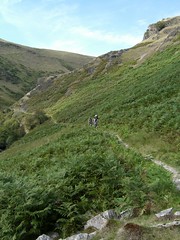One fine morning I set off to chase the last Welsh ruler round his realm.
Owain Glyndwr hasn’t been seen in these parts for 600 years, but his mark is still on the landscape – in old castles he roughed up during his 14-year defiance of Henry IV.
As a marching man, Glyndwr would have been proud to know he now has a whole footpath – more precisely a national trail – named after him. This royal route, subtitled ‘fit for a prince’, opened in 2002, linking places significant to his story.
A lot of other royalty has passed through Welsh history books since then, but I suspect that this famous warrior, characterised as Owen Glendower in Shakespeare’s Henry IV Part One, still commands allegiance in some of the old farms along the path’s course.
You need a brave heart and stout boots to attempt Glyndwr’s Way, along which stiles carry the path’s motif, a roaring red dragon.
This 132-mile epic begins in Knighton, a sort of Clapham Junction of walks – Offa’s Dyke Path passes north to south through this border town.
The official start of Glyndwr’s Way is an elegant sliver of slate near the Clock Tower. It then travels left past the Golden Lion and up alongside the Wylcwm Brook.
In mid-Wales towns quickly peter out and the countryside kicks in. True to form, the path led up a slope, past Scots pine and a glowing outbreak of gorse.
A sign declared the local spectator sport: Sheepdogs – here – Saturday. This path comes with an introductory leg-stretching offer.
Try the first six miles and if not entirely satisfied, or if defeated by some tricky inclines and testing turns, give up at Llangunllo and take the train back, to Shrewsbury or Swansea, on the Heart of Wales Line. Glyndwr may sneer, but no one else need know.
I ambled on, untempted by the train, and was narrowly missed by a farmer bouncing urgently past on a quad bike.
There’s profit as well as grandeur in these hills. Men who toiled to sustain the Welsh industrial miracle – coal miners and iron and steel workers – would be wryly amused to know that today a great Welsh export is water.
The hills collect it after it has filtered through layers of rock ‘to achieve its exceptional taste and purity’. I passed the modest little plant where they bottle mineral water from the Radnor Hills for smart tables everywhere.
In the market town of Llanidloes, under the elegant three-arched bridge, I found Britain’s longest river, the Severn.
A drop that passes under me here takes 36 hours to reach the sea. It rises in the peat bogs 1,600ft up in the hills close to the summit of Plynlimon, which is where I was heading.
Living dragons are hard to spot in Wales, but I saw a red kite hovering above. This is its kingdom; the great bird was persecuted by the Victorians when it scavenged in the streets of London and it retreated to remoter parts of mid-Wales and prospered. (Now, of course, it’s reintroduced cousins are common across Oxfordshire and Bucks.)
The views over Cardigan Bay and north to Snowdonia were sensational. The low evening sun turned the area bright gold. It seemed the modern patron saint of this region – ITV weather lady Sian Lloyd – was right.
On the Cambrian Railway brochure she promises sun ‘all along the line’ from Shrewsbury to Aberystwyth and Pwllheli.
Earlier in the day I forgave her slight error when I sat in fine drizzle under a mountain ash on the slopes at Hyddgen, where, outnumbered, Glyndwr won his most important victory.
I walked down the Roman Steps past Celtica, a visitor centre presenting the history and culture of the Celts, and into Machynlleth, known as Macc and the trail mid-point. Glyndwr held his parliament here in 1404, but the exciting link is with Pennal, just to the west.
The Pennal Letter, part of his negotiations with his allies, was drafted after Glyndwr was crowned Prince of Wales. Maybe at this point the path should deviate to Paris where, in 1406, Glyndwr sent the goatskin parchment letter. It has been there ever since.
At my farmhouse B&B the hostess must have been expecting a marauding warlord. She sat me down to a massive chicken casserole.
Next day I headed back east, to the remote high ground of bracken-cloaked hills at the edge of Snowdonia National Park.
First stop was the Centre for Alternative Technology, where every weather forecast is good. The centre and restaurant are powered with renewable energy: gales keep the windmill spinning; the sun drives solar heating.
Last stop was Lake Vyrnwy, which keeps Liverpool in water. Glyndwr might have fought to save this valley from drowning, but that’s ancient history.
Another Prince of Wales, the future Edward VII, performed the lake’s opening ceremony more than 100 years ago and today, above the water, the area is a national nature reserve. The RSPB has installed user-friendly hides beside the car park.
The path then ambles over the hills, alongside the preserved steam railway at Llanfair and on to Welshpool.
Once more I met the Severn, my drop of water long since delivered to the sea. The path ends in a little park near the pretty Montgomery Canal Basin.
From here it’s one stop to Shrewsbury by rail, or several million steps – by Offa’s Dyke Path – back down to Knighton as a 25-mile encore.
Tempted? No. I had paid my homage to Owain: I took the train.

